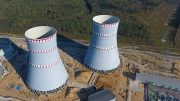
A new study warns that today’s rapid release of greenhouse gases and deforestation could trigger severe and prolonged climate changes, emphasizing the urgent need for global action to protect vegetation and mitigate climate change. Credit: SciTechDaily.com
Examining historical climatic shifts, researchers have identified how vegetation’s response to drastic temperature increases can extend the warming period for millennia.
- Disruption of the functioning of vegetation due to warming can lead to the failure of climate regulating mechanisms for millions of years.
- Vegetation changes can alter the planet’s climate equilibrium.
- Geological and climatic history provide insight into the effects of global warming today.
Scientists often seek answers to humanity’s most pressing challenges in nature. When it comes to global warming, geological history offers a unique, long-term perspective. Earth’s geological history is spiked by periods of catastrophic volcanic eruptions that released vast amounts of carbon into the atmosphere and oceans. The increased carbon triggered rapid climate warming that resulted in mass extinctions on land and in marine ecosystems. These periods of volcanism may also have disrupted carbon-climate regulation systems for millions of years.
Modeling Past Climate Events
Earth and environmental scientists at ETH Zurich led an international team of researchers from the University of Arizona, University of Leeds, CNRS Toulouse, and the Swiss Federal Institute for Forest Snow and Landscape Research (WSL) in a study on how vegetation responds and evolves in response to major climatic shifts and how such shifts affect Earth’s natural carbon-climate regulation system.
Drawing on geochemical analyses of isotopes in sediments, the research team compared the data with a specially designed model, which included a representation of vegetation and its role in regulating the geological climate system. They used the model to test how the Earth system responds to the intense release of carbon from volcanic activity in different scenarios. They studied three significant climatic shifts in geological history, including the Siberian Traps event that caused the Permian-Triassic mass extinction about 252 million years ago. ETH Zurich professor, Taras Gerya points out, “The Siberian Traps event released some 40,000 gigatons (Gt) of carbon over 200,000 years. The resulting increase in global average temperatures between 5 – 10°C caused Earth’s most severe extinction event in the geologic record.”
Long-Term Impacts of Climatic Shifts
“The recovery of vegetation from the Siberian Traps event took several millions of years and during this time Earth’s carbon-climate regulation system would have been weak and inefficient resulting in long-term climate warming,” explains lead author, Julian Rogger, ETH Zurich.
Researchers found that the severity of such events is determined by how fast emitted carbon can be returned to Earth’s interior – sequestered through silicate mineral weathering or organic carbon production, removing carbon from Earth’s atmosphere. They also found that the time it takes for the climate to reach a new state of equilibrium depended on how fast vegetation adapted to increasing temperatures. Some species adapted by evolving and others by migrating geographically to cooler regions. However, some geological events were so catastrophic that plant species simply did not have enough time to migrate or adapt to the sustained increase in temperature. The consequences of which left its geochemical mark on climate evolution for thousands, possibly millions, of years.
Relevance to Contemporary Climate Challenges
What does this mean for human-induced climate change? The study found that a disruption of vegetation increased the duration and severity of climate warming in the geologic past. In some cases, it may have taken millions of years to reach a new stable climatic equilibrium due to a reduced capacity of vegetation to regulate Earth’s carbon cycle.
“Today, we find ourselves in a major global bioclimatic crisis,” comments Loïc Pellissier, Professor of Ecosystems and Landscape Evolution at ETH Zurich and WSL. “Our study demonstrates the role of a functioning of vegetation to recover from abrupt climatic changes. We are currently releasing greenhouse gases at a faster rate than any previous volcanic event. We are also the primary cause of global deforestation, which strongly reduces the ability of natural ecosystems to regulate the climate. This study, in my perspective, serves as a ‘wake-up call’ for the global community.”
Professor Ben Mills, Professor of Earth System Evolution at the University of Leeds’s School of Earth and Environment, said: “Our work confirms that the Earth can respond to climate change in ways that are very dangerous for animal life. Ancient periods of climate change lasted well beyond the cessation of carbon emissions, and it is possible that the climate can permanently transition to a warmer state.
“The events in our study took place millions of years ago and played out over hundreds of thousands of years. But they tell a cautionary tale for the present day. Temperature-driven collapse of the world’s tropical forests has happened before and can happen again.”
Reference: “Biogeographic climate sensitivity controls Earth system response to large igneous province carbon degassing” 8 August 2024, Science.
DOI: 10.1126/science.adn3450









“The Siberian Traps event released some 40,000 gigatons (Gt) of carbon over 200,000 years. The resulting increase in global average temperatures between 5 – 10°C caused Earth’s most severe extinction event in the geologic record.”
That is, on average, about 0.2 Gt of carbon per year. Compare that to the anthropogenic carbon emissions of about 10 Gt per year. Assuming that the temperature increase is proportional, we should experience about 250 to 500 (50X) deg over 200,000 years, or about 0.001 to 0.003 degrees per year. The numbers aren’t coming together! One of the problems is that CO2 doesn’t have a life time of 200,000 years, and we don’t have a fossil fuel resource that will last 200,000 years. Making a comparison is fraught with problems. It would appear that the authors haven’t done their homework.
“We are currently releasing greenhouse gases at a faster rate than any previous volcanic event.”
It probably wasn’t the warmth that was directly responsible for the Permian Extinction Event. The magma intruded into coal beds, releasing coal tars (think toxic and carcinogenic benzene), carbon monoxide, mercury, and toxic sulfur oxides. The volcanic emissions of CO2, HCl, HF, and sulfur oxides (all except CO2 generating strong acids when dissolved in water) also probably rapidly decreased the pH of the oceans (ACTUAL “acidification). If large numbers of marine organisms die from the reduced oxygen in the water, and actual acidic pH values, bacteria will further deplete oxygen levels both in the water and air as they decompose the remains. One has the makings of a catastrophe!
The Eocene was a period of rapid warming that resulted in a similar rapid evolution of mammals in a salubrious jungle-like climate. They found the warmth quite to their liking.
“We are also the primary cause of global deforestation, which strongly reduces the ability of natural ecosystems to regulate the climate.”
Recently, archaeologists have discovered extensive evidence of past occupation of the Amazon Basin with evidence of extensive human modification of the ecosystem:
https://scitechdaily.com/rewriting-history-new-research-reveals-that-there-are-thousands-of-undiscovered-pre-columbian-sites-in-the-amazon-rainforest/
https://scitechdaily.com/archaeologists-reveal-evidence-of-hidden-populations-in-the-amazon/
https://scitechdaily.com/scientists-discover-2500-year-old-lost-valley-of-cities-in-the-amazon/
https://scitechdaily.com/dark-earth-deciphered-ancient-amazonians-intentionally-created-fertile-dark-earth/
These discoveries were revolutionary with respect the role humans had previously played in deforestation and climate change caused by land use changes. The anthropogenic land use changes almost certainly created extensive warming, at least in South America. The point being, just a few hundred years have removed much of the obvious evidence of the land use changes and allowed the land to revert(?) to the previous conditions. It didn’t take millions, or even thousands of years.